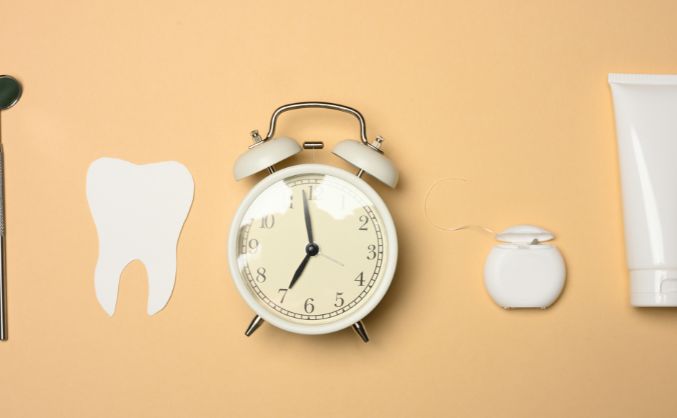Starting the journey to a straighter smile with braces often leads to an important question: How long does it take to get braces? Understanding the timeline is key to setting expectations for your orthodontic treatment.
Generally, getting braces put on takes about one to two hours, but the length of time you’ll wear them varies. In this post, we’ll walk you through each stage of the process, from your first consultation to the day your braces come off. We’ll give you a clear picture of what to expect and discuss the factors that can affect the length of your treatment.
Gearing Up: Initial Consultation and Preparation
The journey to a perfect smile begins with an initial consultation. The American Association of Orthodontists (AAO) recommends an initial evaluation by age 7. Early intervention can prevent future problems or make future treatment easier. Adults can also benefit from orthodontics, and the consultation process remains the same.
During this visit, the orthodontist assesses your dental health and discusses the best treatment options. The preparation phase includes taking X-rays, photographs, and dental impressions. These diagnostic tools are essential for planning your treatment.
The time span between your initial consultation and the actual placement of braces can range from a few weeks to several months. Timing depends on the complexity of your dental issues and the scheduling availability at the orthodontic office.
Getting Braced for a Straighter Smile: The Application Process
Once you and your orthodontist decide on braces, the next step is the application process. The process of getting braces applied typically takes one to two hours. Here’s what you can expect during the visit:
- Prep Time: Your orthodontist will begin by thoroughly cleaning and drying your teeth to ensure a strong bond for the brackets.
- Bracket Bonding: Your orthodontist will attach the brackets to each tooth using a small amount of glue. A blue light hardens the adhesive, securing the brackets in place.
- Archwire: Next, they’ll thread a thin, flexible archwire through the brackets on each tooth. This wire acts like a gentle train track, guiding your teeth into their ideal positions.
- Securing the Smile: Your orthodontist will add small elastic bands or ties to fasten the archwire to the brackets. The elastics come in a variety of colors to choose from, allowing you to pick your favorites.
- Final Touches: Your orthodontist will examine your bite and make any required adjustments.
After the braces are in place, you’ll need to visit the orthodontist regularly for adjustments. You usually have appointments every 4-6 weeks to monitor progress and make adjustments to the wires and bands. For more information on follow-up visits, check out this article from Oral-B.
Beyond the Braces: How Long Will Your Smile Transformation Take?
While getting braces applied itself is a breeze, the true transformation unfolds over time. The total duration of your orthodontic treatment depends on several factors, including:
- The Complexity of Your Case: The severity of your orthodontic issue plays a big role. For example, minor crowding might require less time than correcting a significant overbite.
- Your Body’s Unique Response: Everyone’s teeth move at their own pace. Some patients experience faster movement than others.
- Commitment: Following your orthodontist’s guidelines for retainer use and oral hygiene is essential to avoid delays and ensure progress.
Generally speaking, most people wear braces for 18-24 months. However, some cases may require a shorter or longer timeframe. During your consultation, your orthodontist will provide a more precise estimate based on your individual needs. Remember, orthodontic treatment is an investment in your oral health and confidence.
Start Your Journey to a Perfect Smile with Dr. Murray Orthodontics!

Now that you understand the timeline and process involved in getting braces, you might be ready to take the next step. Dr. Murray Orthodontics is here to guide you through every stage of your orthodontic journey. At Dr. Murray Orthodontics, we’re passionate about creating beautiful smiles and building lasting relationships with our patients. Schedule your consultation today and let’s discuss how we can help you achieve your smile goals!
Frequently Asked Questions (FAQs)
Q: Does it hurt to get braces?
A: Applying braces typically isn’t painful, but you might experience some discomfort afterward. To reduce inflammation and relieve pain, consider using an over-the-counter pain reliever, such as ibuprofen or acetaminophen. For immediate relief in the affected area, an oral anesthetic like Anbesol or Orajel can be effective.
Q: What foods can I eat after getting braces?
A: After having your braces fitted, it is best to eat soft foods that won’t put pressure on the braces or irritate your gums. Suitable choices include yogurt, smoothies, soups, and mashed potatoes. As you become accustomed to your braces, you may gradually incorporate more solid foods into your diet.
Q: How do I choose the right type of braces for me?
A: Choosing the right type of braces depends on your specific needs, preferences, and budget. Your orthodontist can discuss the benefits of each type of braces, including metal, tooth-colored, and other options.
Q: How can I maintain good oral hygiene with braces?
A: A water flosser can be a helpful tool during orthodontic treatment. It can make it easier to clean around the braces, wires, and hard-to-reach areas of your mouth, improving your oral hygiene.

